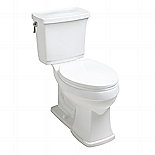
Whatever you call it…a toilet, commode, the john, or any other name, the proper name is water closet.
Throughout the centuries, the basic fundamentals of how toilets work, haven’t changed much, the basic are the same. One of the largest changes came in 1992, when the U.S. government mandated that all new toilets had to be “low flow,” using 1.6 gallons of water per flush rather than the previous three to five gallons. One modern twist to the toilet is the dual flush, which changes the water volume depending on the type of waste being, flushed the small button for number 1, and the larger button for number 2. I don’t think you need more detail than that.
Because the toilet is a fairly simple mechanism, there are a limited number of things that can go wrong. But I have to say, there are a lot of subtitles with a water closet though.
- The connection between the ballcock or fill valve and the supply line bringing water to the toilet can loosen and begin to leak.
- The rubber valve seal in the fill valve breaks down, which is like opening a faucet and walking away. You’ll get a big water bill.
- The rubber gasket where the tank bolts into the bowl will loosen over time as people sit, stand and lean back. Which will lead to water on the floor or carpet if you have a house form the 80’s.
- The wax ring seal where the toilet sits on the floor, between the drain and the bottom of the toilet bowl, can break down as people get on and off the toilet. When this happens it can rot out the subfloor. If the wax seal leaks you’ll have to pull up the toilet and replace the wax seal and possibly repair the sub-floor.
If you can hear the leak, that would be the flush valve or the flapper. An easy test for this is putting some food coloring into the tank and not flushing the water closet for a few hours. If when you come back and find colored water in the bowl you’ll know you have a leaking flapper.
Toilet repair kits are available at hardware and home improvement stores.
If you attempt to fix it yourself, the first and most important step is to turn the water off at the emergency shut off valve. The refill valve usually sticks out of the bottom of the tank, and the supply pipe connects the two.
While a leaky toilet may not seem like a serious problem, the U.S. Environmental Protection Agency estimates that a leaky toilet can waste about 200 gallons of water a day or 1,400 gallons a week. Now that’s a lot of water in any ones books.
How it works:
The chain attaches to the handle and the flapper. When you push the handle, it pulls the chain, which is connected to the flapper or flush valve. The chain lifts the flapper, which then floats out of the way, revealing a 2- to 3-inch diameter drain hole. Uncovering the hole lets water enter the bowl. One and a half gallons of water rush from the tank into the bowl. The flush valve than resets itself. The rush of water activates the siphon in the bowl. The siphon sucks everything in the bowl down the drain. As the bowl empties, air enters the siphon tube, producing that distinctive gurgling sound. Meanwhile, as the water level in the tank falls, the float falls. The falling float turns on the refill valve. Water flowing through the refill valve refills the tank as well as the bowl. As the tank refills, the float rises, and when it reaches an adjusted level, the refill valve shuts off. If something goes wrong and the refill valve keeps running, the overflow tube prevents a flood.
Now you know the basics of how that china commode works, or is it a water closet, a john, a loo, toilet? Whatever it’s called it’s nice when the darn thing works like it’s supposed too.
ABT Plumbing, Electric, Heating & Air Conditioning
(530) 886-8700
